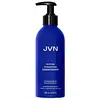What's inside
What's inside
 Key Ingredients
Key Ingredients

 Benefits
Benefits

 Concerns
Concerns

 Ingredients Side-by-side
Ingredients Side-by-side

Water
Skin ConditioningStearyl Alcohol
EmollientCetyl Alcohol
EmollientHydrogenated Farnesene
EmollientBrassicamidopropyl Dimethylamine
Skin ConditioningCinnamidopropyltrimonium Chloride
Squalane
EmollientCamellia Japonica Seed Oil
EmollientGlycerin
HumectantCetearyl Olivate
Sodium PCA
HumectantArginine
MaskingGlycine
BufferingAlanine
MaskingSerine
MaskingProline
Skin ConditioningValine
MaskingThreonine
Isoleucine
Skin ConditioningHistidine
HumectantPhenylalanine
MaskingPCA
HumectantTocopherol
AntioxidantCitrus Reticulata Peel Oil
MaskingSodium Lactate
BufferingSorbitan Olivate
EmulsifyingAspartic Acid
MaskingSodium Gluconate
Skin ConditioningEthylhexylglycerin
Skin ConditioningBenzyl Alcohol
PerfumingParfum
MaskingHexyl Cinnamal
PerfumingLimonene
PerfumingWater, Stearyl Alcohol, Cetyl Alcohol, Hydrogenated Farnesene, Brassicamidopropyl Dimethylamine, Cinnamidopropyltrimonium Chloride, Squalane, Camellia Japonica Seed Oil, Glycerin, Cetearyl Olivate, Sodium PCA, Arginine, Glycine, Alanine, Serine, Proline, Valine, Threonine, Isoleucine, Histidine, Phenylalanine, PCA, Tocopherol, Citrus Reticulata Peel Oil, Sodium Lactate, Sorbitan Olivate, Aspartic Acid, Sodium Gluconate, Ethylhexylglycerin, Benzyl Alcohol, Parfum, Hexyl Cinnamal, Limonene
Water
Skin ConditioningCetearyl Alcohol
EmollientBehentrimonium Chloride
PreservativeGlycerin
HumectantCetyl Esters
EmollientIsopropyl Myristate
EmollientIsopropyl Alcohol
SolventPhenoxyethanol
PreservativeParfum
MaskingLauryl PEG/PPG-18/18 Methicone
Skin ConditioningCetyl Alcohol
EmollientSodium Cocoyl Amino Acids
CleansingBehentrimonium Methosulfate
Citric Acid
BufferingChlorhexidine Digluconate
AntimicrobialQuaternium-33
Isostearyl Alcohol
EmollientPotassium Dimethicone PEG-7 Panthenyl Phosphate
Skin ConditioningDodecene
MaskingSodium Sarcosinate
Poloxamer 407
EmulsifyingPropylene Glycol
HumectantBenzyl Benzoate
AntimicrobialArginine
Masking2-Oleamido-1,3-Octadecanediol
Skin ConditioningHydrolyzed Soy Protein
HumectantHydrolyzed Vegetable Protein Pg-Propyl Silanetriol
Skin ConditioningSodium Chloride
MaskingTetrasodium EDTA
Potassium Sorbate
PreservativeWater, Cetearyl Alcohol, Behentrimonium Chloride, Glycerin, Cetyl Esters, Isopropyl Myristate, Isopropyl Alcohol, Phenoxyethanol, Parfum, Lauryl PEG/PPG-18/18 Methicone, Cetyl Alcohol, Sodium Cocoyl Amino Acids, Behentrimonium Methosulfate, Citric Acid, Chlorhexidine Digluconate, Quaternium-33, Isostearyl Alcohol, Potassium Dimethicone PEG-7 Panthenyl Phosphate, Dodecene, Sodium Sarcosinate, Poloxamer 407, Propylene Glycol, Benzyl Benzoate, Arginine, 2-Oleamido-1,3-Octadecanediol, Hydrolyzed Soy Protein, Hydrolyzed Vegetable Protein Pg-Propyl Silanetriol, Sodium Chloride, Tetrasodium EDTA, Potassium Sorbate
Ingredients Explained
These ingredients are found in both products.
Ingredients higher up in an ingredient list are typically present in a larger amount.
Arginine is an amino acid that is important for human development. Your body uses is it to produce hair keratin and skin collagen.
As a cosmetic ingredient, Arginine has antioxidant properties and can also help repair damaged skin. This ingredient is derived either synthetically or from animals.
Arginine isn't fungal acne safe when used in the presence of other lipids (fats, fatty acids, oils, esters, etc). Oils and fats occur naturally within the skin, so take caution when using Arginine if you're prone to fungal acne.
Learn more about ArginineCetyl Alcohol is a fatty alcohol. Fatty Alcohols are most often used as an emollient or to thicken a product.
Its main roles are:
Though it has "alcohol" in the name, it is not related to denatured alcohol or ethyl alcohol.
The FDA allows products labeled "alcohol-free" to have fatty alcohols.
Learn more about Cetyl AlcoholGlycerin is already naturally found in your skin. It helps moisturize and protect your skin.
A study from 2016 found glycerin to be more effective as a humectant than AHAs and hyaluronic acid.
As a humectant, it helps the skin stay hydrated by pulling moisture to your skin. The low molecular weight of glycerin allows it to pull moisture into the deeper layers of your skin.
Hydrated skin improves your skin barrier; Your skin barrier helps protect against irritants and bacteria.
Glycerin has also been found to have antimicrobial and antiviral properties. Due to these properties, glycerin is often used in wound and burn treatments.
In cosmetics, glycerin is usually derived from plants such as soybean or palm. However, it can also be sourced from animals, such as tallow or animal fat.
This ingredient is organic, colorless, odorless, and non-toxic.
Glycerin is the name for this ingredient in American English. British English uses Glycerol/Glycerine.
Learn more about GlycerinParfum is a catch-all term for an ingredient or more that is used to give a scent to products.
Also called "fragrance", this ingredient can be a blend of hundreds of chemicals or plant oils. This means every product with "fragrance" or "parfum" in the ingredients list is a different mixture.
For instance, Habanolide is a proprietary trade name for a specific aroma chemical. When used as a fragrance ingredient in cosmetics, most aroma chemicals fall under the broad labeling category of “FRAGRANCE” or “PARFUM” according to EU and US regulations.
The term 'parfum' or 'fragrance' is not regulated in many countries. In many cases, it is up to the brand to define this term.
For instance, many brands choose to label themselves as "fragrance-free" because they are not using synthetic fragrances. However, their products may still contain ingredients such as essential oils that are considered a fragrance by INCI standards.
One example is Calendula flower extract. Calendula is an essential oil that still imparts a scent or 'fragrance'.
Depending on the blend, the ingredients in the mixture can cause allergies and sensitivities on the skin. Some ingredients that are known EU allergens include linalool and citronellol.
Parfum can also be used to mask or cover an unpleasant scent.
The bottom line is: not all fragrances/parfum/ingredients are created equally. If you are worried about fragrances, we recommend taking a closer look at an ingredient. And of course, we always recommend speaking with a professional.
Learn more about ParfumWater. It's the most common cosmetic ingredient of all. You'll usually see it at the top of ingredient lists, meaning that it makes up the largest part of the product.
So why is it so popular? Water most often acts as a solvent - this means that it helps dissolve other ingredients into the formulation.
You'll also recognize water as that liquid we all need to stay alive. If you see this, drink a glass of water. Stay hydrated!
Learn more about Water